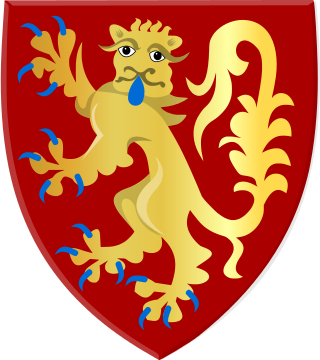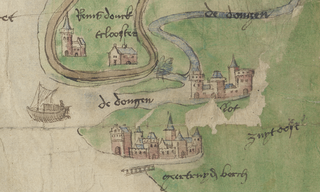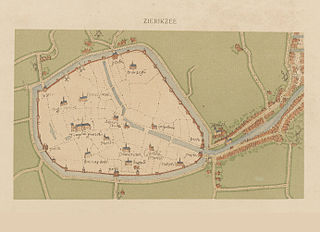
Margaret II of Avesnes was Countess of Hainaut and Countess of Holland from 1345 to 1356. She was Holy Roman Empress and Queen of Germany by marriage to Holy Roman Emperor Louis IV the Bavarian.

The Hook and Cod wars comprise a series of wars and battles in the County of Holland between 1350 and 1490. Most of these wars were ostensibly fought over who should hold the title of "Count of Holland", but some have argued that the underlying reason was a power struggle conducted by the bourgeois in the cities against the ruling nobility.

Albert I, Duke of Lower Bavaria, was a feudal ruler of the counties of Holland, Hainaut, and Zeeland in the Low Countries. Additionally, he held a portion of the Bavarian province of Straubing, his Bavarian ducal line's appanage and seat, Lower Bavaria.

William I, Duke of Bavaria-Straubing, was the second son of Emperor Louis IV and Margaret II of Hainaut. He was also known as William V, Count of Holland, as William III, Count of Hainaut and as William IV, Count of Zeeland.

William II of Bavaria was Duke of Bavaria-Straubing and count of Holland, Hainaut and Zeeland. He ruled from 1404 until 1417, when he died from an infection caused by a dog bite.

The Battle of Zwartewaal was a decisive naval battle during the Hook and Cod wars.

Dirk III van Brederode was lord of Brederode.

Brederode Castle, also called the Ruins of Brederode, is located near Santpoort-Zuid. The castle was founded in the second half of the 13th century by William I van Brederode (1215–1285). William was a descendant of the lords van Teylingen, who were related to the counts of Holland. The castle formed part of the high lordship Brederode, which had been given in loan in the 13th century to the lords of Brederode by the count of Holland.

John II, Lord of Polanen was Lord of Polanen, Lord of De Lek and Lord of Breda.

Polanen Castle was a castle located in today's Monster, South Holland in the Netherlands. The ancestral home of the Polanen family, it suffered a siege in 1351 and was demolished in 1394. It was replaced by a small manor somewhat to the south.

The Cod Alliance Treaty was a 1350 or 1351 treaty by which a number of nobles and cities allied with William V of Holland against his mother Margaret II, Countess of Hainaut and her allies. It was signed in the first phase of the Hook and Cod wars.

The Battle of Veere was a small naval battle that took place in late May 1351 during the Hook and Cod wars.

Dirk III van Wassenaar was Heer van Wassenaar and burggraaf (burgrave) of Leiden.

Gerard (III) van Heemskerk, Lord of Heemskerk was a leader of the Cod Alliance during the opening phases of the Hook and Cod wars

Machteld van Voorne was Lady of Voorne, Monschau and Valkenburg, and burgrave of Zeeland. During the Hook and Cod wars she was an important ally of Count William V of Holland.

Floris I van BorselenFlorens de Bersalia was lord of Sint-Maartensdijk and Sint-Maartensdijk Castle, the count's lieutenant in Zeeland and keeper of the seal of Holland.

Geertruidenberg Castle was a major medieval castle in Geertruidenberg, then part of County of Holland now in North-Brabant, Netherlands
The Siege of Geertruidenberg (1351-1352) was a long siege of Geertruidenberg Castle during the first of the Hook and Cod wars.

The Siege of Zierikzee (1351) was a relatively unknown siege of Zierikzee during the first of the Hook and Cod wars.

Philips I, Lord of Polanen became Lord of Polanen in 1345. He later became Lord of Capelle, Nieuwerkerk, and Uyterlier. Philips was an important commander during the Hook and Cod wars.


















